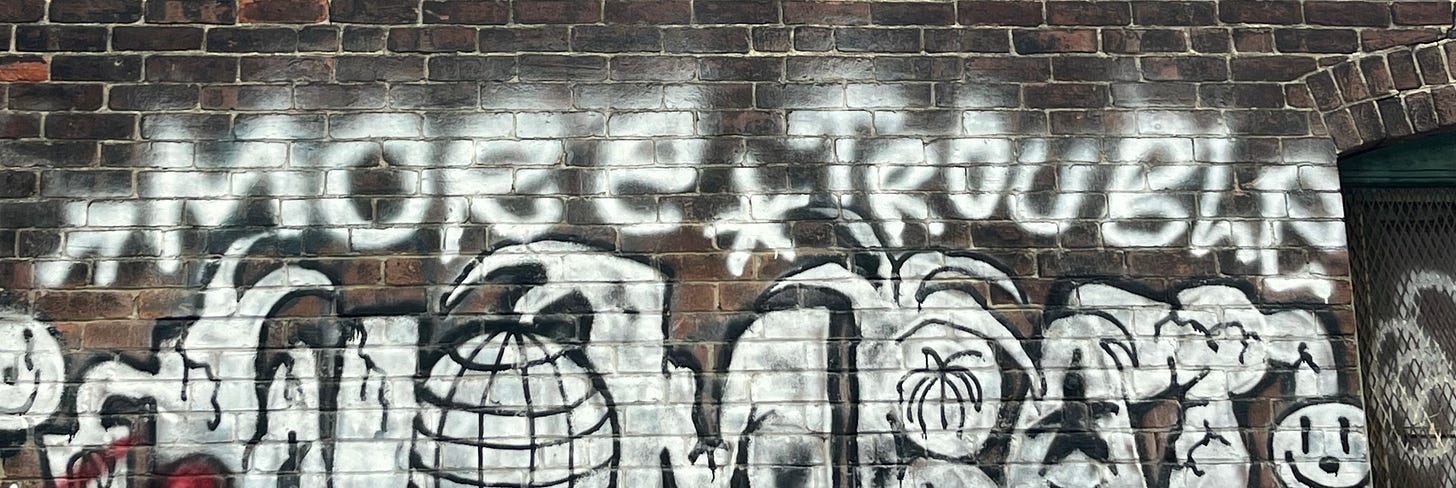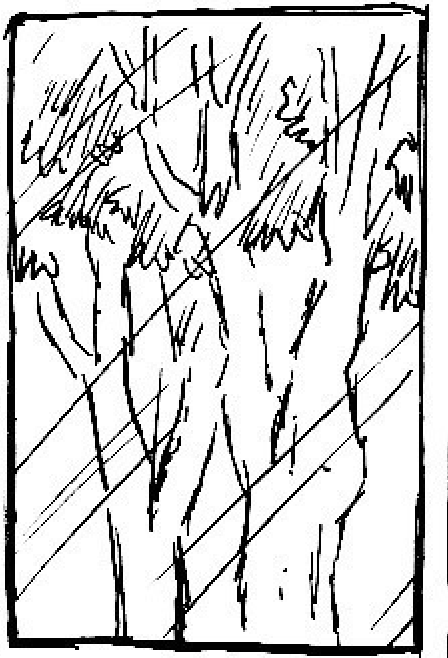This summer, I began to hold irregular, inadvertent, and, in some cases, ill-advised office hours at the coffee shop downstairs.
The other day, Sonny put his small, worn canvas bag on the sidewalk and pulled up a chair. I use the term “his” loosely. Just about everything he has or wears is a found object. I doubt he’s ever stolen anything except perhaps under duress. He just attracts and lets go of things that he’s found here and there. To me, Sonny’s not a scavenger; he’s more like a miner of the everyday. The bag looked like something he’d had his whole life and would keep using until the cloth frayed so badly it simply couldn’t hold anything more than a book or two.
He’d probably found it the day before.
When it comes to mining everyday objects, Kenny, of course, sets the gold standard. A title he’s earned by quantity, although not necessarily quality. He’s convinced that no one knows the worth of anything except him, whether he finds it in a dumpster, junkyard, or way under-priced at a flea market—the kind with many objects that have seen their share of fleas. He often shows me something that he got for like $4 that he could easily sell for $75. Sometimes, I wonder how he gets rid of it all. Until a couple of weeks ago when I found out.
One day, I heard that a body was being fished out of the Whetstone Brook near the Co-op1 and that the person’s name was Kenny. I know the idea of a body getting fished out of a brook in a small Vermont town like Brattleboro, (pop. 12,000) might strike you as odd but way stranger things have happened in way smaller towns.
Since the Whetstone Brook isn’t very deep, rumors began surfacing pretty quickly that one of my neighbors had run afoul of the dope dealers up from Springfield, Massachusetts. The fact that the police said the death wasn’t suspicious made people even more suspicious.
However, it appears that this Kenny was not killed by some gang, at least not directly. Rather, I have it on reasonably good authority that he had taken way too much of a drug (crack, crank, crystal, ketamine, who knows?) and ended up diving or falling into the brook and hitting his head on a rock. Or getting snagged on something somehow and drowning.
Anyway, I quickly asked around and was assured it wasn’t “my” Kenny. Still, I hadn’t seen him for a few days, so I went to his campsite to double-check. I’m one of the few people who knows where it is—besides the parks and recreation officials in New Hampshire who, after tolerating it for a while, recently told him to break camp.
I’d tried going there once before, based on a general description he’d given me—down a virtually invisible path off a well-traveled trail that led to a small tent halfway down the hill towards the river. The tent seemed too small for full-time living, although it looked lived-in enough to be his. But he wasn’t there.
Later, when I told him I’d found it, he looked at me like the idiot he’s convinced I am and said that the tent I had found was just a decoy; the real tent was further down. So, a few days after hearing about the unsuspicious death, I went back, passed the decoy tent, and worked my way down a narrow, but still noticeable trail until I rounded a corner and came upon a bucolic campsite: a small plateau of land in the woods with a full view of the river but invisible to anyone walking the path above.
There was a larger, far more suitable tent towards the back of the area, an American flag hung on a clothesline on the river side and, between them, some found objects scattered on the ground in an area the size of a standard living room (which, for Kenny, it was.)
Did I say “some” objects? Did I say “scattered”? Did I mention the two or three supermarket shopping carts I’d seen along the path?
I wasn’t looking at some objects. I was looking at dozens. Maybe hundreds. Tools, pots and pans, children’s toys, and furniture in various states of disrepair. A few worn and torn blankets and pieces of clothing. A couple of lamps and flashlights. Silverware. Old signs. Metal book racks. All set out as if assembled by a crack addict running a junkyard. Or a pothead like Kenny who, in the right frame of mind, can find beauty in all things.
It is one of the not-so-great regrets of my life that I didn’t take a picture. I can only excuse myself by saying that, while I wasn’t surprised, I was in shock.
I’m used to seeing unkempt tent sites by the river. On a smaller scale. Ones that could be cleaned up with a couple of garbage bags. This would need a dumpster.
On the other hand, I thought, trying to shift my reaction from shock to awe, Kenny does have an amazing eye for finding useful discarded objects. Maybe, at first, he had laid out these things in some kind of order. Maybe there still was some order beneath the chaos.
Regardless—maybe I’ve been reading too much Thoreau lately—no matter how hard I tried to find some beauty or elegance or even charm in the scene, it simply reaffirmed my belief that humans are the only invasive species.
The next time I saw Kenny he told me he’d been asked to take his campsite and all his stuff away. He assured me that was no problem and even told me where his new campsite was going to be and that he would be having a housewarming. As yet, I haven’t been to either his old or new campsite. Or received an invitation to the housewarming. I probably won’t. Because Kenny’s mad at me again. That’s yet another story.
But I digress. Back to my friend Sonny. At a table on the sidewalk.
This piece is beginning to be arranged as haphazardly as Kenny’s tentsite. But it does capture the flavor of their lives and my interractions with them.
Sonny held out what looked like a large bike lamp or a small shop lamp. “You want this?” Sonny often pulls things out of “his” bag de jour and offers them to you. Rarely does he name a price and his tone of voice makes it sound like there is none. He just wants you to have it. And assumes you’ll want to give him some money in return.
I took it and tried turning it on. But it didn’t work. Seeing it had a USB port and realizing Sonny might not have come across a USB cable that day, I said I’d see if I could get it to work. He said, “Sure, take it.”
By then, he had taken a few stalks of what looked like long thick grass out of the bag. He broke one in half and bent over to squeeze the juice onto a cracked area near the heel of his right foot.
“Aloe?” I asked.
“Yeah. I gotta start taking better care of my feet.”
“Where’d you find aloe outside?”
“Over there,” he gestured so vaguely I couldn’t tell if he meant further up Main Street, in Paris, or on the moon.
Sonny, like Kenny, is a bit of a throwback. He looks like an old scraggly hippie with dredlocks who after some encounter with drugs, a traumatic life event, and/or simply the mysterious ways of brain chemistry, lost his everyday footing and tumbled back into the ‘60s.
Watching him continue to break aloe stalks in half and squeeze out the juice, I realized that, like Kenny, he knew not only the basics of what’s good for what, but also where to find it.
For example, seeing me gimp along one day, Kenny had told me he’d get some fresh comfrey from a bush up by the town hall, boil it down into a salve of some sort, and give it to me to apply regularly to my bad knee. He said it would be better in like two days. He never got around to it and, although I admit I got some comfrey salve from the Co-op and gave it a half-hearted try, I didn’t cancel my appointment with an orthopedic surgeon.
To be Continued.





